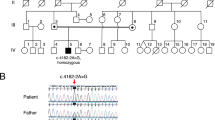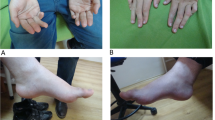Abstract
Autosomal recessive hereditary spastic paraplegia (AR HSP) with thin corpus callosum (TCC) is a rare neurodegenerative disorder often caused by mutations in the gene encoding for spatacsin at the SPG11 locus on chromosome 15q. The disease is characterized by progressive spastic paraparesis and mental retardation which occur during the first two decades of life and frequently with peripheral neuropathy. Brain magnetic resonance imaging (MRI) reveals typical TCC with periventricular white matter changes. We describe two patients, of Turkish descent, from the same consanguineous family and affected with SPG11 in association with unusual early-onset parkinsonism. Parkinsonism occurred during the very early stages of SPG11 in both patients, being in one the inaugural symptom of the disease presented as a resting tremor with akinesia, rigidity and expressing an initial moderate levodopa-response that progressively weakened. The second patient presented a resting tremor with mild akinesia and no levodopa-response. Both patients were affected with progressive spastic paraparesis which had initially occurred at 15 and 12 years of age, respectively, in association with mild mental retardation and an axonal polyneuropathy. TCC with periventricular white matter changes (PWMC) was evident by MRI and 123I-ioflupane SPECT was abnormal. Genetic analysis detected for both patients a new c.704_705delAT, p.H235RfsX12 homozygous mutation in SPG11. This report provides evidence that parkinsonism may initiate SPG11-linked HSP TCC and that SPG11 may cause juvenile parkinsonism.
Similar content being viewed by others
References
Boukhris A, Stevanin G, Feki I, Denis E, Elleuch N, Miladi MI, Truchetto J, Denora P, Belal S, Mhiri C, Brice A (2008) Hereditary Spastic Paraplegia With Mental Impairment and Thin Corpus Callosum in Tunisia: SPG11, SPG15, and Further Genetic Heterogeneity. Arch Neurol 65:393–402
Coutinho P, Barros J, Zemmouri R, Guimaraes J, Alves C, Chorao R, Lourenco E, Ribeiro P, Loureiro JL, Santos JV, Hamri A, Paternotte C, Hazan J, Silva MC, Prud’homme JF, Grid D (1999) Clinical heterogeneity of autosomal recessive spastic paraplegias: analysis of 106 patients in 46 families. Arch Neurol 56:943–949
Del Bo R, Di Fonzo A, Ghezzi S, Locatelli F, Stevanin G, Costa A, Corti S, Bresolin N, Comi GP (2007) SPG11: a consistent clinical phenotype in a family with homozygous spatacsin truncating mutation. Neurogenetics 8:301–305
Hehr U, Bauer P, Winner B, Schule R, Olmez A, Koehler W, Uyanik G, Engel A, Lenz D, Seibel A, Hehr A, Ploetz S, Gamez J, Rolfs A, Weis J, Ringer TM, Bonin M, Schuierer G, Marienhagen J, Bogdahn U, Weber BH, Topaloglu H, Schols L, Riess O, Winkler J (2007) Long-term course and mutational spectrum of spatacsin-linked spastic paraplegia. Ann Neurol 62:656–665
Howard HC, Mount DB, Rochefort D, Byun N, Dupre N, Lu J, Fan X, Song L, Riviere JB, Prevost C, Horst J, Simonati A, Lemcke B, Welch R, England R, Zhan FQ, Mercado A, Siesser WB, George AL Jr, McDonald MP, Bouchard JP, Mathieu J, Delpire E, Rouleau GA (2002) The K-Cl cotransporter KCC3 is mutant in a severe peripheral neuro pathy associated with agenesis of the corpus callosum. Nature Gen 32:384–392
Iwabuchi K, Kubota Y, Hanihara T, Nagatomo H (1994) Three patients of complicated form of autosomal recessive hereditary spastic paraplegia associated with hypoplasia of the corpus callosum. No to shinkei = Brain and Nerve 46:941–947
Kang SY, Lee MH, Lee SK, Sohn YH (2004) Levodopa-responsive parkinsonism in hereditary spastic paraplegia with thin corpus callosum. Parkinsonism Relat Disord 10:425–427
Lee MJ, Cheng TW, Hua MS, Pan MK, Wang J, Stephenson DA, Yang CC (2008) Mutations of the SPG11 gene in patients with autosomal recessive spastic paraparesis and thin corpus callosum. J Neurol Neurosurg Psychiatry 79:607–609
Martinez Murillo F, Kobayashi H, Pegoraro E, Galluzzi G, Creel G, Mariani C, Farina E, Ricci E, Alfonso G, Pauli RM, Hoffman EP (1999) Genetic localization of a new locus for recessive familial spastic paraparesis to 15q13-15. Neurology 53:50–56
Nakamura A, Izumi K, Umehara F, Kuriyama M, Hokezu Y, Nakagawa M, Shimmyozu K, Izumo S, Osame M (1995) Familial spastic paraplegia with mental impairment and thin corpus callosum. J Neurol Sci 131:35–42
Okubo S, Ueda M, Kamiya T, Mizumura S, Terashi A, Katayama Y (2000) Neurological and neuroradiological progression in hereditary spastic paraplegia with a thin corpus callosum. Acta Neurol Scand 102:196–199
Orlacchio A, Kawarai T, Totaro A, Errico A, St George-Hyslop PH, Rugarli EI, Bernardi G (2004) Hereditary spastic paraplegia: clinical genetic study of 15 families. Arch Neurol 61:849–855
Paisan-Ruiz C, Dogu O, Yilmaz A, Houlden H, Singleton A (2008) SPG11 mutations are common in familial cases of complicated hereditary spastic paraplegia. Neurology 70:1384–1389
Simpson MA, Cross H, Proukakis C, Pryde A, Hershberger R, Chatonnet A, Patton MA, Crosby AH (2003) Maspardin is mutated in mast syndrome, a complicated form of hereditary spastic paraplegia associated with dementia. Am J Hum Genet 73:1147–1156
Stevanin G, Azzedine H, Denora P, Boukhris A, Tazir M, Lossos A, Rosa AL, Lerer I, Hamri A, Alegria P, Loureiro J, Tada M, Hannequin D, Anheim M, Goizet C, Gonzalez-Martinez V, Le Ber I, Forlani S, Iwabuchi K, Meiner V, Uyanik G, Erichsen AK, Feki I, Pasquier F, Belarbi S, Cruz VT, Depienne C, Truchetto J, Garrigues G, Tallaksen C, Tranchant C, Nishizawa M, Vale J, Coutinho P, Santorelli FM, Mhiri C, Brice A, Durr A (2007) Mutations in SPG11 are frequent in autosomal recessive spastic paraplegia with thin corpus callosum, cognitive decline and lower motor neuron degeneration. Brain 131:772–784
Stevanin G, Montagna G, Azzedine H, Valente EM, Durr A, Scarano V, Bouslam N, Cassandrini D, Denora PS, Criscuolo C, Belarbi S, Orlacchio A, Jonveaux P, Silvestri G, Hernandez AM, De Michele G, Tazir M, Mariotti C, Brockmann K, Malandrini A, van der Knapp MS, Neri M, Tonekaboni H, Melone MA, Tessa A, Dotti MT, Tosetti M, Pauri F, Federico A, Casali C, Cruz VT, Loureiro JL, Zara F, Forlani S, Bertini E, Coutinho P, Filla A, Brice A, Santorelli FM (2006) Spastic paraplegia with thin corpus callosum: description of 20 new families, refinement of the SPG11 locus, candidate gene analysis and evidence of genetic heterogeneity. Neurogenetics 7:149–156
Stevanin G, Santorelli FM, Azzedine H, Coutinho P, Chomilier J, Denora PS, Martin E, Ouvrard-Hernandez AM, Tessa A, Bouslam N, Lossos A, Charles P, Loureiro JL, Elleuch N, Confavreux C, Cruz VT, Ruberg M, Leguern E, Grid D, Tazir M, Fontaine B, Filla A, Bertini E, Durr A, Brice A (2007) Mutations in SPG11, encoding spatacsin, are a major cause of spastic paraplegia with thin corpus callosum. Nature Gen 39:366–372
Winner B, Uyanik G, Gross C, Lange M, Schulte-Mattler W, Schuierer G, Marienhagen J, Hehr U, Winkler J (2004) Clinical progression and genetic analysis in hereditary spastic paraplegia with thin corpus callosum in spastic gait gene 11 (SPG11). Arch Neurol 61:117–121
Zhang SS, Chen Q, Chen XP, Wang JG, Burgunder JM, Shang HF, Burgunder JM, Yang Y (2008) Two novel mutations in the SPG11 gene causing hereditary spastic paraplegia associated with thin corpus callosum. Mov Disord 23:917–919
Author information
Authors and Affiliations
Corresponding author
Rights and permissions
About this article
Cite this article
Anheim, M., Lagier-Tourenne, C., Stevanin, G. et al. SPG11 spastic paraplegia. J Neurol 256, 104–108 (2009). https://doi.org/10.1007/s00415-009-0083-3
Received:
Revised:
Accepted:
Published:
Issue Date:
DOI: https://doi.org/10.1007/s00415-009-0083-3




